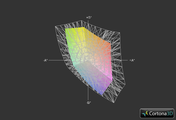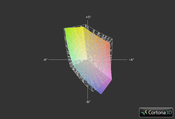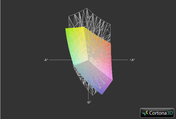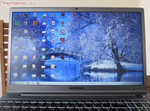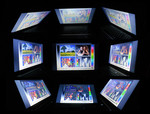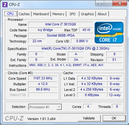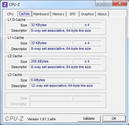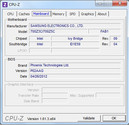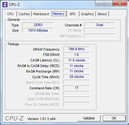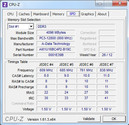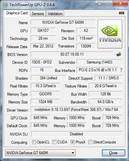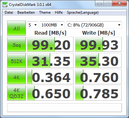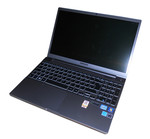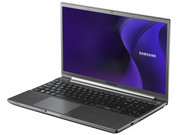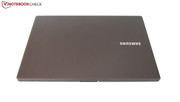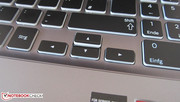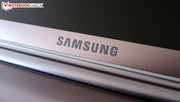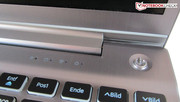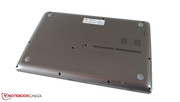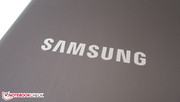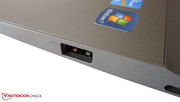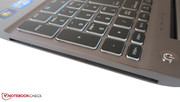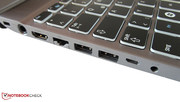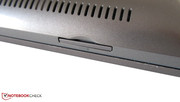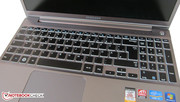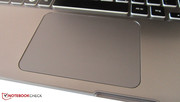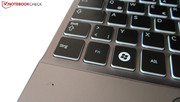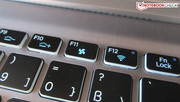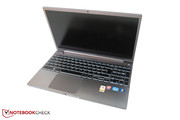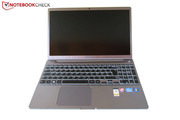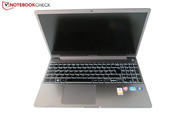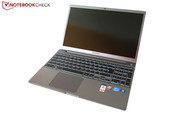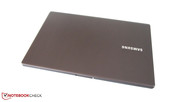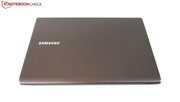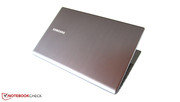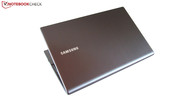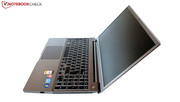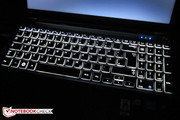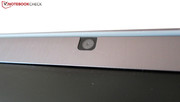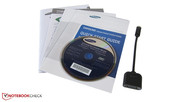Review Samsung Series 7 700Z5C Notebook

For the original German review, see here.
The Samsung 700Z5C-S04 is an update to the previously-tested 700Z5A, which poses a serious threat to the competition with its appealing aluminum design, backlit keyboard, matte screen, HD resolution (1600x900 pixels) and powerful hardware.
In comparison to the predecessor (i5-2430M and AMD Radeon HD 6750M), the successor is upgraded to the latest standard: the quad-core i7-3615QM CPU. Samsung has switched the GPU to the GeForce GT640M.
As Samsung has "updated" its hardware, we will take a brief look at the case, connectivity and input devices. For further information, we recommend the review of the Samsung 700Z5A.
Case
As in the 700Z5A, the compact dimensions of our test model are surprising. These are achieved with a very thin and good-looking aluminum display border; despite having a 15.6-inch screen our test model looks like a handy 14-inch model. The high-quality, elegant, brushed aluminum design, which is employed on the base of the laptop and the display cover, has stayed the same.
Sadly, as our test model uses the same design, the same flaws we picked out in the previous review (poor sturdiness, especially on the right side, above the optical drive and lax hinges) are present in the 700Z5C-S04.
All-in-all, the case and the workmanship of the Series 7 Chronos models is usually at a good and respectable level.
Connectivity
The connectivity has not changed from the predecessor and as such we point the reader to the review of the Samsung 700Z5A for more information.
Input Devices
Keyboard
The input devices are, like in the predecessor, one of the strengths of the Samsung 700Z5C-S04. The chiclet keyboard includes a numeric pad and offers keys with appropriate size and grip. The keys have good feedback thanks to the stroke distance and a crisp, yet not hard impact. Another pro is the backlighting of the keyboard, which has 8 levels.
Touchpad
The Samsung Series 7 Chronos offers good quality in the touchpad as well. The device measures 107 x 77 cm (quite large) and offers multi-touch gesture support for up to 4 fingers (modeled after the Apple notebook touch gestures). The recognition and precision of the device is good, but it is not as good as the predecessor. The well-sized surface and great sliding properties have won us over.
Display
Unfortunately, the 700Z5A continues to use the screen of the predecessor and this proves to be the Achilles' heel of the test model.
"SuperBright" - that is what Samsung calls its screen. The panel can reach a max brightness of 300cd/m2, but our test model only has a modest illumination of 82%. The matte display coating is a nice feature and so is the HD+ resolution of 1600x900 pixels.
| |||||||||||||||||||||||||
Brightness Distribution: 82 %
Center on Battery: 204 cd/m²
Contrast: 144:1 (Black: 1.81 cd/m²)
38.66% AdobeRGB 1998 (Argyll 3D)
56.3% sRGB (Argyll 3D)
37.41% Display P3 (Argyll 3D)
In terms of picture quality, the TN panel is weak. The black value and contrast are slightly higher than in the predecessor but they are still lacking: 1.81 (black value) and 144:1 (contrast). This results in poor picture quality and colors look pale. The black on the screen seems dark grey.
The color space coverage is similar to the 700Z5A: the panel cannot cover the sRGB color space and thus it is not for professional picture and graphics editors. The slightly more expensive Sony Vaio SV-S1511X9E presents a clear gap.
The viewing angle stability of the laptop is not great. The colors of the TN panel radically change as the viewing angle deviates (especially vertically). This is a serious weakness of the TN panel technology, but higher-quality panels can employ this technology and yet offer better viewing angles.
Performance
Of course, the interesting point when looking at the Samsung 700Z5C is performance.
Samsung installs the latest hardware in their test model: an entry-level quad-core CPU, i7-3615QM, from Intel and an Nvidia GeForce GT 640M.
A hybrid version is available for faster boot and shorter load times. This version combines a traditional HDD with a mini SSD (8 GB) from SanDisk. This system ("Express Cache") is familiar from the predecessor, the 700Z5A, but that model was equipped with a faster 7200 rpm Hitachi HDD. Our test model has to make do with a slower 5400 rpm HDD, which is apparent from the slower access times, but the HDD offers 1 TB storage space.
The multimedia notebook is equipped with 8 GB RAM, of which 4 GB is securely soldered. The second slot, like in the 700Z5A, is accessible via a flap.
Processor
The Intel Core i7-3615QM in the Samsung 700Z5C belongs to the entry-level i7 quad-core CPUs and is clocked at 2.3 GHz. The well-known Turbo Boost technology allows the chip to boost its speed up to 3.3 GHz, as long as the cooling system can keep up.
As usual, we ran the CPU of our test model through various benchmarks. The results of the Cinebench tests lived up to our expectations: 5379 points in Cinebench R10 64 Bit (Single core rendering). The 3615QM can show its real power in the Multi-core rendering: it takes a lead over the 2430M of the predecessor by 100%. Even the so-called Turbo Boost is used in the Rendering and the CPU boosts up to 3.1 GHz and falls just shy of the 3.3 GHz limit.
System Performance
Of course, besides the pure CPU performance, we are interested in the overall performance of the Samsung 700Z5C-S04, which is measured using PC Mark 7 and PC Mark Vantage (with various use scenarios).
As expected, the hardware of the multimedia notebook (3615QM and GT 640M) offers enough performance reserves for all the various scenarios. However, the performance is slowed down a little by the relatively slow 5400 rpm HDD.
2962 points in PC Mark 7 and 7933 points in PC Mark Vantage present standard, yet good scores for this hardware, but the system still lags significantly behind a "true" SSD system.
The increase in performance (in comparison to the predecessor, 700Z5A, with the faster 7200 rpm HDD) is mainly due to the stronger CPU and GPU.
| PCMark Vantage Result | 7933 points | |
| PCMark 7 Score | 2962 points | |
Help | ||
Storage Devices
As mentioned before, the multimedia laptop uses a hybrid storage device comprised of an HDD and an SSD. These hybrid systems are growing in popularity as the duo combine the fast boot up speeds of a small SSD cache with the large capacity of a traditional HDD. In comparison to a "pure" SSD, the hybrid system is far cheaper.
Samsung has picked a 5400 rpm HDD for its laptop. This model is slower than the 7200 rpm HDD found in the predecessor. It is a pity, as this presents a large gap in terms of speed to an SSD. In fact, the laptop even scores slightly lower than the 700Z5A. Sadly, the 1 TB capacity can not make up for this flaw.
Graphics Performance
Along with the CPU, Samsung has updated the GPU of the 700Z5C-S04 as well.
Now, the manufacturer has switched from the AMD Radeon HD 6750M of the predecessor to the middle-class Nvidia GeForce GT 640M.
This GPU is very popular and is the successor to the GT 540M from last year. The GPU offers strong multimedia performance and can even run the latest games at reduced quality settings.
Futuremark measures the graphics performance of the system. The Samsung 700Z5C scores 12378 points (3DMark 06) and 1968 points (3DMark 11) - very good. This performance is especially good when compared to previous systems with the GT 640M and hints at a decent gaming performance.
| 3DMark 06 Standard Score | 12378 points | |
| 3DMark Vantage P Result | 8551 points | |
| 3DMark 11 Performance | 1968 points | |
Help | ||
Gaming Performance
The synthetic benchmarks give us a good estimate of the graphics and computing power of the system. However, the practical gaming performance is the deciding factor.
We tested the Samsung model with a few of the latest PC games: like Assassin's Creed 3 or Hitman Absolution.
As expected, Hitman Absolution, which is a demanding game, quickly pushes the notebook to its limits. This means the resolution and level of details have to be lowered to enjoy a fluid game experience. Still, the Samsung multimedia laptop does not hide itself, as it can leave its mark in our gaming benchmarks and top the predecessor, the 700Z5A with a Radeon HD 6750M, by a significant amount.
Gaming enthusiasts will not be satisfied with this performance, but occasional gamers, who do not wish to run the newest games in Full HD and at high settings, will be happy with the 700Z5C. The notebook can run most games at the native resolution of 1600x900 pixels with medium to high settings. Older, less demanding games can even use max details.
| low | med. | high | ultra | |
|---|---|---|---|---|
| Crysis 2 (2011) | 60.2 | 59.7 | 53.4 | 17.3 |
| The Elder Scrolls V: Skyrim (2011) | 63.9 | 48.5 | 36.69 | 20.81 |
| Anno 2070 (2011) | 123.5 | 47.3 | 28.15 | 14.26 |
| Fifa 13 (2012) | 299.5 | 199.6 | 186.2 | 123 |
| Dishonored (2012) | 98.5 | 86.3 | 79 | 49.29 |
| Hitman: Absolution (2012) | 54.8 | 38.89 | 23.62 | 8.39 |
| Assassin´s Creed III (2012) | 45.89 | 39.12 | 13.96 |
Emissions
Our test model is not much different from the 700Z5A in this area. While idle (low load, typing or surfing the web), the notebook turns the fans off and the only emission is the barely noticeable HDD whoosh. The notebook is almost noiseless in this state.
Of course, the emissions rise at load. The fan turns on so as to push out the heat produced by the hardware and the noise emission rises to clearly audible, but still acceptable, 42 db (average).
Noise level
| Idle |
| 31.4 / 31.6 / 32.2 dB(A) |
| HDD |
| 31.6 dB(A) |
| DVD |
| 34.3 / dB(A) |
| Load |
| 42.1 / 42.1 dB(A) |
 | ||
30 dB silent 40 dB(A) audible 50 dB(A) loud |
||
min: | ||
Temperature
The temperature emissions are similar to the Samsung 700Z5A. Although the temperatures are slightly higher than in the predecessor, the case remains cool (especially the hand-rest regions). The bottom of the laptop heats up significantly but remains well within acceptable limits. Subjectively, the notebook was warm, rather than hot, but we would not recommend placing the notebook on the lap while playing games.
The internal temperatures were measured with the "HWMonitor" tool while running the stress test (Furmark, Prime95). The CPU temperature averages out to 90 °C (max. 91 °C), which is an average value, but it is achieved through throttling of the CPU (1.3 - 1.4 GHz). The GPU hits a max. 81 °C and remains quite cool. Even at full load the GPU can run for a while at the max clock speed of 709 MHz (boost).
We ran 3DMark 06 at the end of the one hour stress test. The results were similar to the ones previously recorded while the laptop was cool. This means that the user will not have to worry about throttling during practical use.
(±) The maximum temperature on the upper side is 43.2 °C / 110 F, compared to the average of 36.9 °C / 98 F, ranging from 21.1 to 71 °C for the class Multimedia.
(-) The bottom heats up to a maximum of 49 °C / 120 F, compared to the average of 39.2 °C / 103 F
(+) In idle usage, the average temperature for the upper side is 30.5 °C / 87 F, compared to the device average of 31.3 °C / 88 F.
(+) The palmrests and touchpad are cooler than skin temperature with a maximum of 31.9 °C / 89.4 F and are therefore cool to the touch.
(-) The average temperature of the palmrest area of similar devices was 28.7 °C / 83.7 F (-3.2 °C / -5.7 F).
Speakers
The Series 7 Chronos is not the best when it comes to speakers. In comparison to the more high-quality notebooks, the internal speakers of the test model lack volume and music and sound output is a little hollow.
Still, the sound quality is better than that of many multimedia notebooks, which offer thinner and tinny sound output.
Games, videos and conversations over Skype are presented in satisfying quality. We also liked the above-average max volume. It could fill up a medium-sized room.
Energy Management
Power Consumption
The power consumption of the Samsung 700Z5C has risen slightly, in comparison to the 700Z5A. It still lies in a low and completely acceptable region. Thanks to Nvidia Optimus, the switching between the GPU and the IGP is possible and the computer can save power while idle or at low load, thus achieving longer run times.
| Off / Standby | |
| Idle | |
| Load |
|
Key:
min: | |
Battery Life
An important criterion for mobile notebooks is good battery life. The Samsung 700Z5C performs remarkably well in this category, as shown by our measurements while the notebook was running on battery.
The max battery life was measured while the laptop was idle (minimum brightness, "Power Saver" profile) with the Battery Eater Reader test. The laptop ran a good 10 hours and 36 minutes and topped even the strong predecessor, the 700Z5A, with its 80 Wh battery.
The good impression is carried on in the WLAN test (surfing various websites at 150 cd/m2 brightness): 5 hours. The laptop lasts a long 4.5 hours in the DVD play test, which runs at max brightness. This gives the user the option of enjoying a proper movie night.
Verdict
The Samsung 700Z5C is a good model, but the manufacturer has made a few mistakes in critical areas.
The main flaw is the average panel, which is the same as the one in the 700Z5A. The panel has poor viewing angles and the colors are pale. The poor contrast/black value will be a problem for demanding professionals.
However, the panel does offer a resolution of 1600x900 pixels. This is a nice compromise between sharp depiction and keeping the content large enough (words and symbols). The matte coating deserves praise, as this is not easy to find in the competition and can easily prevent reflections.
The case sturdiness belongs to the upper mainstream section: the pressure resistance is not too high and the display hinges are not stiff enough. These flaws are bearable as the Samsung notebook has exceptionally compact measurements (nearly 14-inch case measurements). This slimness can be attributed to the extremely thin aluminum display borders, which in turn, contribute to the looks of the model.
On average, the Samsung 700Z5C-S04 is an attractive packet, which offers a flat, stylish design with aluminum parts, good input devices, high performance and amazing battery life. Many buyers will find good reasons to purchase this model.




